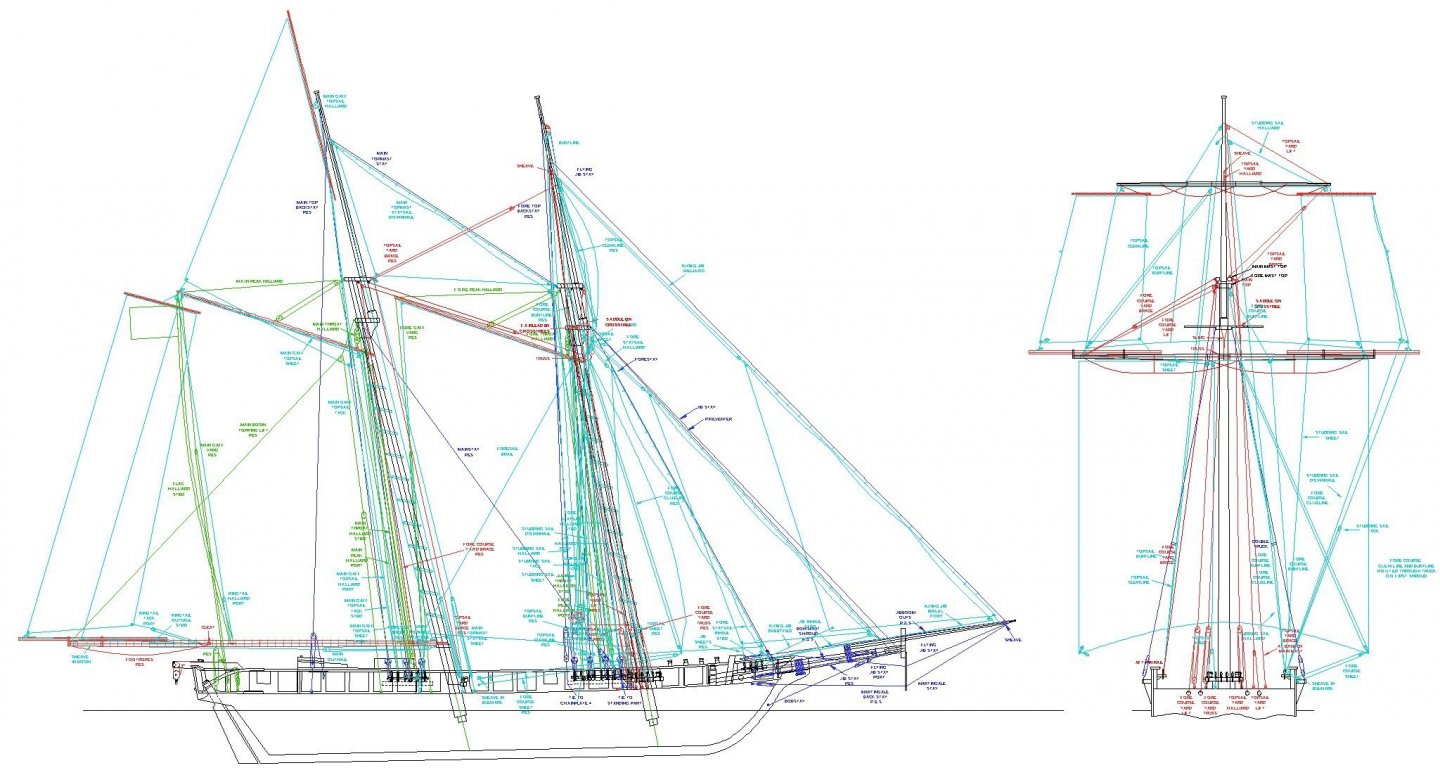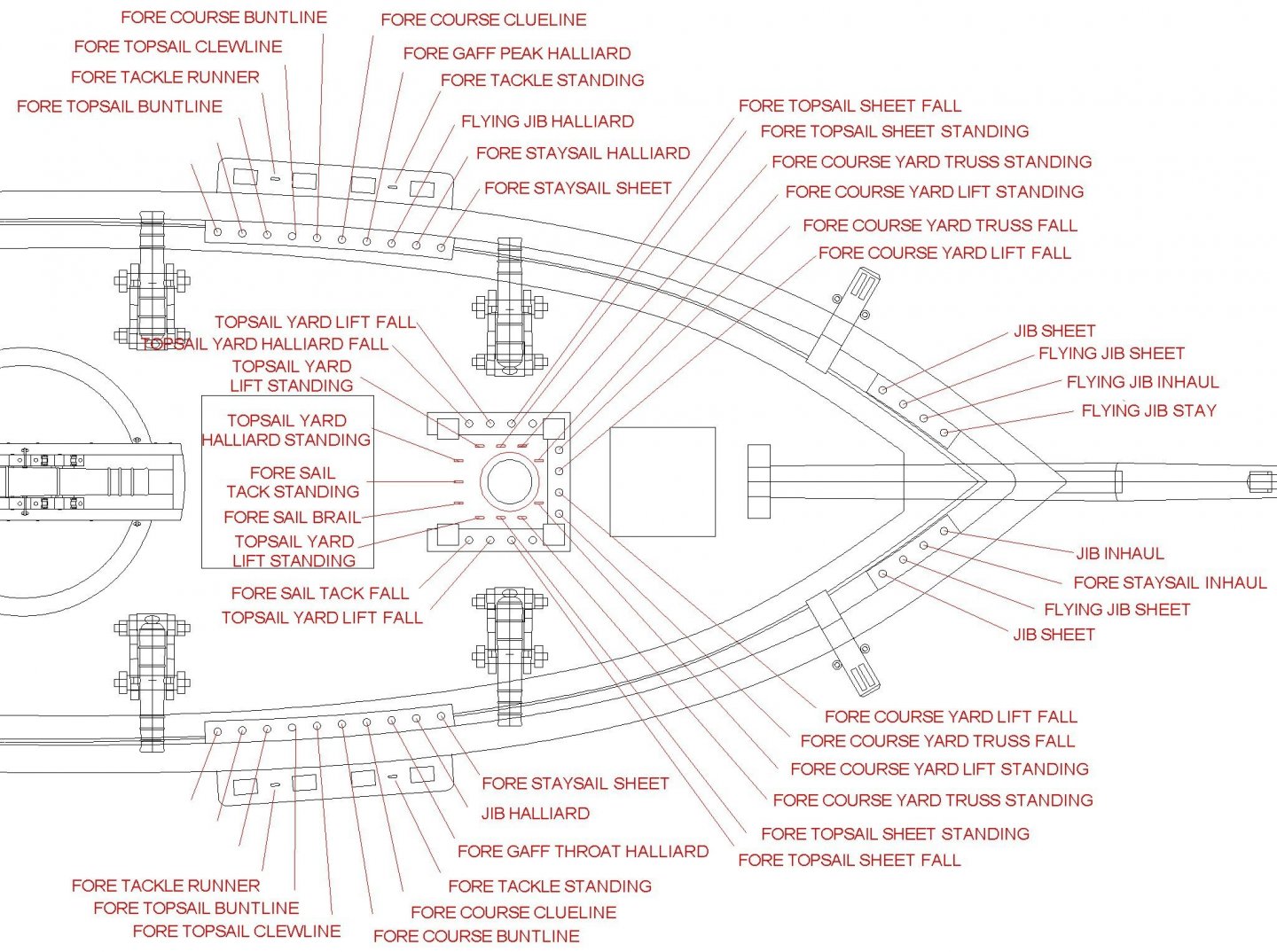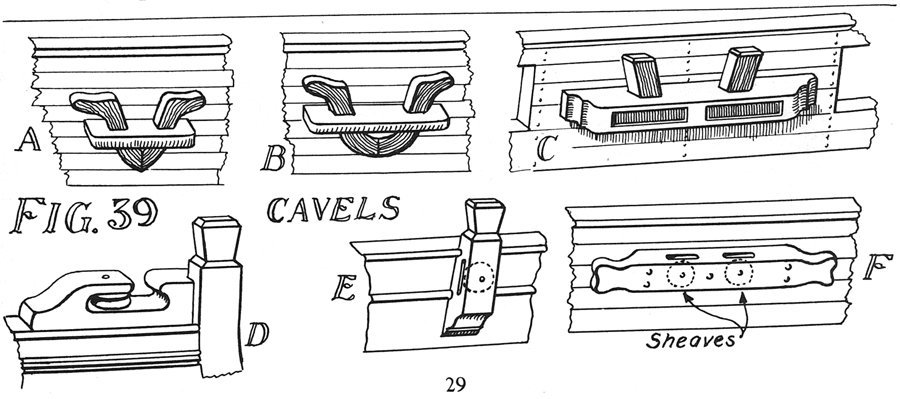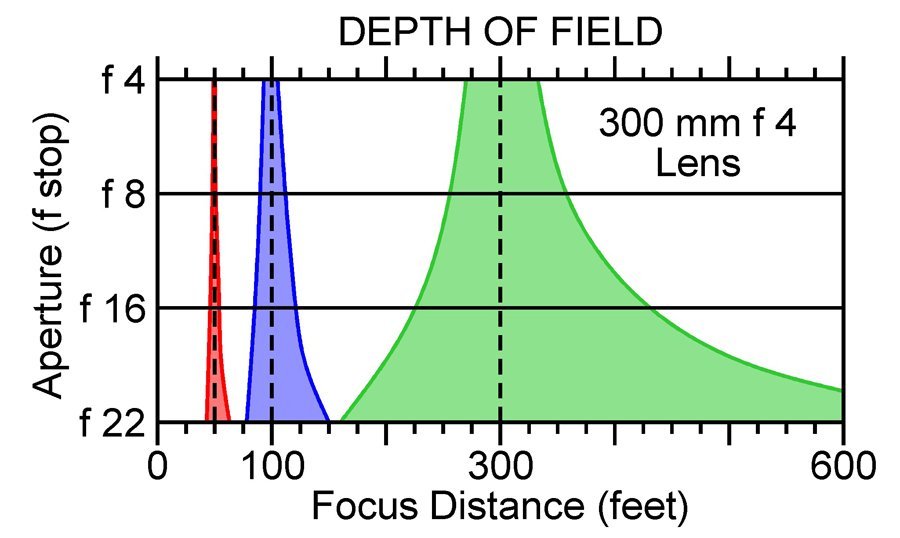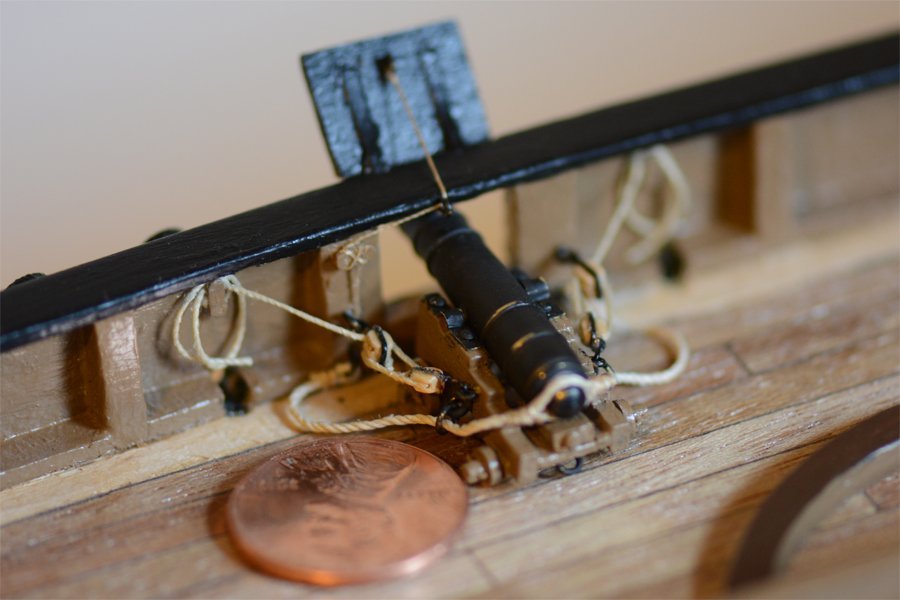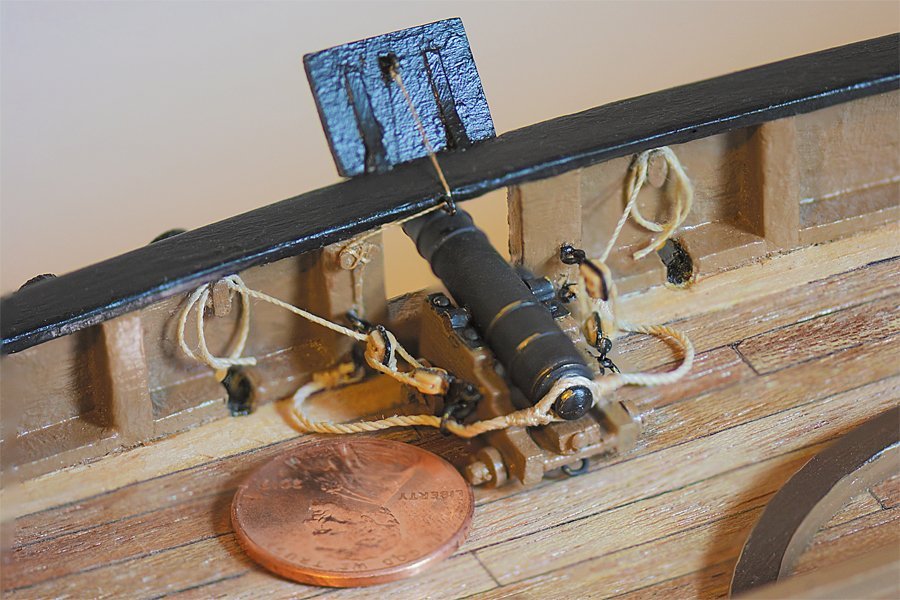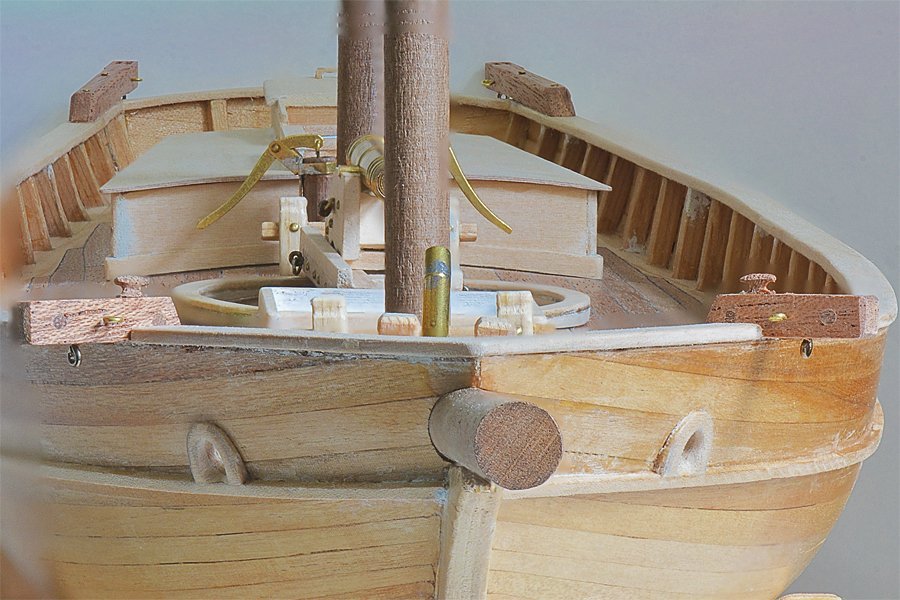-
Posts
2,404 -
Joined
-
Last visited
Content Type
Profiles
Forums
Gallery
Events
Everything posted by Dr PR
-

31 ton Revenue cutter sails and rigging
Dr PR replied to Bill Hudson's topic in Masting, rigging and sails
Bill, I have been puzzling over topsail schooner rigging for my revenue cutter model. I have posted a thread describing the basic sails and rigging here: https://modelshipworld.com/topic/25679-topsail-schooner-sail-plans-and-rigging/?do=findComment&comment=750865 Here is a link to my rigging and belaying plan for a similarly rigged ship as the 31 ton vessel: https://modelshipworld.com/topic/19611-albatros-by-dr-pr-mantua-scale-148-revenue-cutter-kitbash-about-1815/?do=findComment&comment=863237 The 31 ton vessel has a simpler rig (not as many shrouds) than the theoretical 100 ton vessel I am modeling. However, the rigging principals were the same on all two masted fore topsail schooners, so you should get some ideas from these links. -

Black scroll bars
Dr PR replied to Dr PR's topic in Using the MSW forum - **NO MODELING CONTENT IN THIS SUB-FORUM**
Mark, You guessed right! I ended up on the ipsfocus themes page link - the one above the "Themes V" link. I switched to the "ips unedited theme" and that solved the problem. This makes the Model Ship World web site much more user friendly - at least for me. Thanks! -

Black scroll bars
Dr PR replied to Dr PR's topic in Using the MSW forum - **NO MODELING CONTENT IN THIS SUB-FORUM**
I'm sorry if I ruffled a few feathers by suggesting any features that makes a program useless is asinine - but that is my opinion, and it comes from decades of programming experience. I have seen some really bonehead mistakes and poorly designed user interfaces! Now, back to the problem. I opened MSW on Chrome, Opera and Edge, and the scroll bars are light gray background with a dark gray slider. I see Microsoft has purged Internet Explorer from my system in one of the updates, so I can't test it, and Safari never worked correctly on this machine. Edit: Aha! I got Internet Explorer working again, and it has scroll bars with a light background and a dark slider. So the problem is associated with Firefox - my normal browser. I am not surprised. I have created four web sites, and there have always been incompatibilities between browser implementations of HTML and XHTML. Usually it is Microsoft that has the strange implementation! Because I am aware of this I have always tested my code on all the available browsers, and modified it so it works the same on all of them. Apparently the ipsfocus programmers don't have much experience with these problems. I'll fiddle with Firefox settings to see if I can fix the problem. To be continued ... -

Black scroll bars
Dr PR replied to Dr PR's topic in Using the MSW forum - **NO MODELING CONTENT IN THIS SUB-FORUM**
Mark, Thanks! I looked at the different "themes" and the "Illuminate 4.6" does not have this problem. It has a white background with a gray scroll bar. However, I do not see how to change this theme for my account. It looks like ipsfocus wants me to pay $30.00 for the theme (for use in new web pages)! But I have created several web pages and the user cannot change the themes (it is part of the HTML/XHTML/CSS code). **** I am running Windows 10 Home (latest update 9 November 2021) on a Toshiba laptop. I am running the laptop screen at high brightness and high contrast, although I have to say the display is distinctly inferior to the screens on my work station. The Intel HD Display is set for moderate brightness, contrast and gamma that gives me the best resolution with Google Maps. I have Windows configured for pretty much the default options, with a custom background photo. The photo is the remarkable Hubble Deep Field - about 1500 galaxies in a black sky. However, it doesn't cause black backgrounds in the default Windows scroll bars. The windows "Color" setting is "light" and that produces a default white background for open windows. The Color accent is automatic (whatever that means). The current "Theme" is "Custom" because I have selected a custom photo. Theme "color" is automatic. Other programs like Microsoft Office (Word, Excel, PowerPoint, Paint), my CAD programs, Firefox, Chrome, Opera, Safari, Thunderbird, Internet Explorer/Edge, Teams, Zoom, GoTo, photo viewers, eDrawings, and printer/scanner utilities work with no problems with the scroll bars. I have always been suspicious of "themes" created by web page designers who often have no clue what their pretty color schemes will do. Often they seem to be young twits who have spent their entire lives pecking at cell phones and have no understanding of how people use computers! Anything but the operating system default color scheme is just asking for trouble. It reminds me of the program MathCAD. They wanted a distinctive appearance, as if it would somehow improve the performance of the program (and that is all that matters). So they decided to scramble the normal Windows color scheme. But if a user changed the background color in windows it changed the colors in MathCAD in unpredictable ways. Some combinations made menus disappear into the background, others caused the text to disappear from the working window, etc. It made the program useless for anything but the Windows color settings that were on the programmers' computers while they were writing the program, and they weren't using the Windows defaults! Duh! -
George, In the past I have always assembled the masts before stepping them. This allows me to add all the details, such as mast bands, blocks, etc., while the masts are on the work bench. I will add all the rigging to the spars before attaching them to the masts. I will add the shrouds and standing rigging first. This is essential for getting the masts straight and at the proper angles. I may rig these to the masts on the work bench and then attach them to belaying points afterward. However, some of the backstays were "portable" with tackle and hooks that allowed them to be tightened or moved depending upon the tack and positions of the fore and main gaff sails. These can be rigged to the masts on the bench and attached to the belaying points later, after other running rigging is put in place. I will probably follow the general practice of working from bow to stern, starting with the bowsprit. But right now I can't say what sequence I will use. It depends upon what things look like as the build progresses.
-
On my laptop the scroll bars at the right side of the screen are black and the slider and up/down buttons are dark gray - almost always nearly invisible against the black background. Aside from being an asinine choice and extremely user hostile, this choice of colors makes it much more difficult to control the movement of screen content up and down. I have tried to eliminate this problem with the windows setup option - and other web pages don't have this problem, so I am guessing it was a deliberate choice of the person who designed the web pages. Is there some way that we can defeat this extremely irritating color scheme and just get the web page to use the Windows default color scheme for the scroll bar?
-
For the last several months I have been planning and working on small details on deck furniture, and puzzling over how the rigging was belayed on deck. Very few books go into detail about schooner rigging, and those that do give good details how the rigging is arranged aloft and then say the lines "go to the deck." That isn't a lot of help!! The Mantua plans show only the standing rigging and say nothing of the running rigging. There are not nearly enough belaying points (pin rails, ring bolts, cleats, etc.) to handle the running rigging. I have finally come up with a rigging plan and belaying plan that I intend to use on the model. First the full rigging illustration: This is a bit different from my earlier plan. Instead of a spar gaff topsail on the fore mast I am using a main top staysail. And I am still considering adding a traveller to the jib boom for the flying jib rigging. Here is the belaying plan: This plan was made a bit more complicated by the pivot gun that fires above the bulwarks. Several lines might optimally be located along the bulwark between the middle and aft cannons, but these would be blown away by the pivot gun. Several belaying point shuffles were necessary to get everything tied down without fouling the lines. Of course this is preliminary. When I start rigging the model I may have to rearrange some of the lines to avoid tangling and chafing the lines. I have also attached a PDF file listing all the lines (standing and running), their termination points and lengths (dimensions are in inches). Part of this exercise was to calculate the lengths of the lines so I know what to order. There are a little over 200 lines totaling about 182 feet (55.47 meters), and that doesn't count coils of rope at the belaying points, or the cannon rigging. Revenue Cutter Rigging Terminations.pdf
-
Allan, I think you are correct that rigging connections to ring bolts were always attachments for standing parts of tackle. All but one of the ring bolt connections I have shown are for tackle connections. However, I hastily placed the fore sail brail on a ring bolt - it should go to a belaying pin or cleat, and I will change this. Whether or not a running rigging line (or some standing rigging lines for that matter) needs a tackle is a matter of conjecture. You really need to know how the line is used when the ship is underway. This was brought home to me in Harold Underhill's "Masting and Rigging the Clipper Ship and Ocean carrier." On page 139 he comments that lower bunt lines on some ships may have whips (single block) for extra purchase (mechanical advantage) while on other ships the line may run straight to a pin. "It is a matter of the work to be done." A straight run requires only a place (pin) to belay the end of the line. But a whip, gun tackle or luff tackle requires a firm attachment for the standing end (a ring bolt on deck, for example) and a pin for the running fall. In another place Underhill notes that clew lines and bunt lines are under no strain when the sail is set, and are left slack so as not to foul or chafe against the sail. Because they are normally slack they lead down straight to the belaying point. Both may be tied off on the same pin since they are both used at the same time while reefing the sail. But the sheet is always under strain when the sail is set, and it may be necessary to attach the running end to a tackle, such as a gun tackle (two single blocks) in order to get enough mechanical advantage to control the sail. Whether or not to use a tackle on a running rigging line depends upon the size of the sail (the work to be done) and the size of the crew. On merchant ships with small crews tackles were more common on running rigging, and in the later years when crews were smaller still other methods such as winches were used. So to really get it right I need to know how to sail the real ship! Lever's "Young Sea Officer's Sheet Anchor" is helpful, but it only talks about full rigged square sail ships and says nothing about schooners. My current model rigging plan uses luff tackles (single and double block) for the heaviest items like the fore course yard lifts and truss, topsail yard halliard, fore sail tack, fore and main tackles (burtons), throat halliards and peak halliards, running back stays, main outhaul and such. Gun tackles (two single blocks) are used for lighter loads like the foresail sheets, topsail yard lift, topsail sheet, staysail halliards and sheets. Whips are used for even lighter loads like vangs, main boom topping lift, topsail sheet, and topsail yard lift. These ideas came from a combination of Lees, Underhill, Petersson and Marquardt, based upon what seems to me to be the extent of the loads. However, this is still preliminary. The schooner I am modelling is not a large vessel, just 70 feet between the perps, 74 feet on deck, and probably about 100 tons. It has only one topsail and no topgallant or royal. No square sails on the main mast. I suppose some of the luff tackles could be gun tackles, some gun tackles could be whips, and some lines with whips might be run straight to the belaying points. Any suggestions?
-
I am building the Mantua Albatros Art 771 kit from the 1980s. I am trying to create a belaying plan for the ship. The main mast is simple, but the fore mast is quite complex. The Mantua plans show only the basic standing rigging, and show none of the running rigging. I have eleven books that discuss sailing ship rigging, including the standards Steel, Lees, Biddlecombe, Lever, etc., but these describe full square-rigged ships and are mostly useless for deriving a schooner rigging and belaying plan. After detailed discussions of how to rig the lines on the masts, spars and sails they all finish by saying the line "runs to the deck." I do have several books that talk specifically about schooner rigging (Petersson, Underhill, Leather, Hahn, Marquardt). Most of these also say to run the line "to the deck" or "to the rail." Again, no help. Petersson's "Rigging Period Fore-and-Aft Craft" shows the belaying plan for a topsail schooner, and is the best reference I have found, but it doesn't describe the variations found on different ships. Underhill's "Masting and Rigging the Clipper Ship and Ocean Carrier" has far and away the best an most detailed discussion of ship rigging I have found, but it is mostly for full-rigged ships, with only a brief discussion of schooners. Marquardt's "Global Schooner" has good detail about rigging but it also says the lines run "to the deck." Leather's "The Gaff Rig Handbook" is nearly useless, having no useful index and focusing mainly upon 20th century racing yachts. So I have been left to my own devices to figure out how to belay the fore mast rigging. I am using two assumptions. First, lines coming down from purchases close to or on the mast lead down to ring bolts or fife rails at the base of the mast (or pins, cleats or spider bands on the mast), and lines running from the yard arms run down to the pin rails or cleats on the bulwarks or to ring bolts in the waterways near the bulwarks. Second, lines from lower purchases lead forward, and lines from higher positions lead aft. The idea is to avoid crossing lines. Here is my working plan: As you can see, there are 35 running rigging lines coming down from the foremast (not counting studding sails!). The base of the mast seems a bit crowded with 21 standing and running lines attached to ring bolts in the deck and pins in the fife rail. To achieve this I had to run the fore course bunt lines and clew lines outboard to the pin rails even though they lead from the lower top and the quarters of the fore course yard. I would appreciate comments and corrections from those who understand belaying better than I do. NOTE: I expect that as I start rigging the mast I will to have to reorder some of these positions to eliminate fouled lines.
-
Allen, This isn't the only confusing terminology I have seen referring to historic ships. Mondfeld (page 163) calls your "kevel" a "staghorn" and his "kevel block" is similar to your "cavel block." However, on page 246 he has a drawing of ropes fastened to one of his staghorns, labeled "Belaying to a kevel!" George Biddlecombe's "The Art of Rigging" (page 18) says a kevel is two crooked pieces of timber with the lower ends together and the heads branching out like horns, agreeing with Lees "cavel." Webster's "Third New International Dictionary" 1966, the font of all knowledge about ships, says a "kevel" or "cavel" is "a strong timber, bollard or cleat ... or a timber bolted across two stanchions." This latter definition is closer to Lees "cavel cleat" on page 170. A kevel is also a staff or hammer. Nordbock's "The Lore of Ships" (page 32) shows a "kevel" similar to Lees "cavel" and Mondfeldths "staghorn." On page 33 he shoes a "kevel head" as a timber mounted to the bulwark next to a cathead, with a top protruding above the cap rail and turned like a timberhead. Charles Davis' "Ship Models How to Build Them" describes a "cavil" as a "stout cleat of wood bolted fore and aft on the inside of the bulwark stanchions" used to secure heavy ropes. Bjorn Landstrom's "Sailing Ships" refers to "large V-shaped cavils" for securing sheets. Campbel's "Neophyte Ship Modeler's Jackstay" (page 28-29) shows nine different "cavels" or"kevels." He says the earliest of the 17th and 18th century were shaped like two horns (Mondfeldt's "staghorns") and shows a Dutch type (A) and an English type (B). The third is the type on the Victory of1765 (C). Another (D) is horizontal with or without a sheave, on the fo'c'sle bulwark to take the end of the catfall tackle (something like Nortbock's "kevel head"). Type E is a "verticle kevel with sheave" from before 1800 (a "kevel block"). The heavier type F was used after 1800. The type G is a lighter type used on schooners, type H was used on English luggers, and last, but not least, is type I, a heavy cavel with a hole that aligned with a mooring port in the bulwark. So it looks like just about anything you can tie a line to is a kevel! Or cavel. Or cavil. I may be belaboring this a bit, but it is just this sort of name differences between authors that has caused me much confusion (and still does) as I try to learn more about sailing ships. Even worse is when authors use various terms without bothering to define them, just assuming that everyone else in the universe can read their minds!
-
The Granado was an interesting ship. I looked in the Anatomy of the Ship book (The Bomb Vessel Granado 1742, Peter Goodwin, Naval Institute Press, 1989) to see what it had to say about these objects. Although there are many detailed drawings of just about every part of the ship - inside and out - I could find none for these parts. In the two page inboard drawing (page 54-55) the aft one is lost in the page fold and the forward one seems to be behind the mast. However, photos of the model on page 32 and 35 do show these parts, and in the close up photo on page 35 it does appear that the post is leaning forward (from bottom to top) slightly, as shown in the drawing Brain posted. I would call these things kevel blocks, and zu Mondfeld (page 163) even has a drawing of one angled as in Brian's drawing (Historic Ship Models, Wolfram zu Mondfeld, Sterling Publishing Company, New York, 1989).
-

Focus Stacking
Dr PR replied to Dennis P Finegan's topic in Photographing your work. How to do this.
DZ, I don't see how anyone could find fault with that picture. It is a great photo of a very nice model. I still have my D200 body but I quite literally wore out the 18-70 mm lens. It had a rough life and I disassembled and repaired it three times over the years before getting a new 16-80 mm f/2.8 lens for newer camera bodies. John is right about depth of field being in the eye of the beholder. For the graph I posted above I just used the depth of field settings on the lens depth of field display. That will tell you it is an old (1970s) lens because the new auto everything lenses no longer have a depth of field display. The graph is by no means super accurate, but it serves well to illustrate the relationship between depth of field, focus distance and f stop. -

Focus Stacking
Dr PR replied to Dennis P Finegan's topic in Photographing your work. How to do this.
I take no offense either. The more opinions the better, and more facts are even better! Even after half a century of photography I am still learning and open to new ideas. I agree that I wouldn't try to use a long focal length lens (telephoto) to photograph a ship model (or anything else) if I was using photo stacking. Generally speaking, the best image magnification you can get on the photo sensor with most lenses not designed for close distance photography is about 0.25x (taken from Nikon lens data). So they aren't very useful for close-up photography. You have to back out to the minimum focus distance for the lens, but that isn't a problem if you are photographing the whole model. In fact, you will probably want to back off even farther to get the entire thing in the image. A macro lens can give you 1x magnification on the image sensor, so it is ideal for close up photography of small details. Even so, with an excellent macro lens you may not have enough depth of field at the focus distance to get one clear image, so photo stacking is very useful. Here are some examples: The image on the left is one of a series of photos of this cannon rigging, taken with the same lighting and f stop. Notice blurring of the far end of the port lid, the bulwark at the right and the close edge of the penny. The image on the right is the result of photo stacking several images shot with the camera at the same position relative to the cannon and different focus distances. All parts of the image are in sharp focus. So photo stacking is useful for small details shot close up with a macro lens. As Charles Green said, depth of field is proportional to focus distance. Here is a graph I prepared for a photography lecture using a lens I have: This lens has a very long minimum focus distance (about 15 feet or 4.5 meters) so it wouldn't be very useful for photographing ship models. But the graph clearly shows the relationship between focus distance and depth of field, and the effect different f stops have on depth of field. Higher f numbers produce greater depth of field. These relationships are true of all lenses, but shorter focal length lenses have much better characteristics at shorter focus distances. But the problem with backing out to longer focus distances to get a greater depth of field is that the photo subject becomes a smaller and smaller part of the field of view. So a longer focal length lens is needed (or longer zoom) to narrow the field to just fit the subject. My experiments with long focal length lenses several decades ago were intended to take advantage of the greater depth of field at longer focus distances and large f numbers, and still get enough magnification to include the entire subject in the field of view. The problem with this approach is that the long focus distances cause the setup to be more sensitive to slight vibrations. If you try this method you must have a far more sturdy camera support than afforded by most tripods and bright lighting. In one case I discovered that my heartbeat was causing regular expansion and contraction of my chest, and this was sending out slight pressure waves that were moving the image in perfect sync with my heartbeat! I had to use a long cable release and step out of the room! -

Focus Stacking
Dr PR replied to Dennis P Finegan's topic in Photographing your work. How to do this.
In the 12 photo sequence I posted above I did see slight image magnification changes with each different focus distance. I see this with image sequences using only a few photos. Photoshop has an "Auto-Align Layers" function that places all images aligned and rescaled so that the features in each image line up at the same size. Then the "Auto-Blend Layers" function does the photo stacking. I agree that the blurred parts of my image were probably not in sharp focus in any of the 12 images, but even when they are I often see blurry perimeters. As the focus distance changes the image magnification changes so the picture area in the first image (closest focus to the camera) is wider than in the last image (most distant focus from the camera). So not all images contain the same picture area. This means the outer parts of the stacked image may not contain any sharp images, so there is nothing there for the focus stack software to choose. I understand the use of a rail - I have three different units. But as was said, trying to use a rail on an object nearly two feet deep would be a lot more difficult than just putting the camera on a tripod and shooting a sequence of individually focused pictures. First, even with a good depth of field (high f number and long exposures) the camera would have to move more than a foot or more. If it was close to the model the image magnification (view angle)would change greatly from start to finish. This would be much more than by just refocusing the lens on a fixed camera. Rather than using a macro lens as I did, a longer focal length lens (telephoto) positioned several feet from the model would help with the magnification change with camera movement. I experimented with this a lot about 40 years ago and got good results with a 300 mm f4 lens. But it requires a very large/long work space. And a long rail. And a very solid vibration free work environment. This brings me to my point. Most of us are not photographing museum pieces, and we don't have the large photo studio with all the specialized camera equipment and long rails. So it isn't "better" for those of us who don't have it. **** One more thing. I have been pretty successful hand holding my camera and macro lens while photographing wildflowers outdoors - and photo stacking multiple images to get a great depth of field. Everyone says you can't photo stack hand held images, and they are wrong. Photoshop's "Auto-Align Layers" does a very good job compensating for small camera motion differences. It works most of the time if you know what you are doing - and there isn't a lot of breeze blowing the flowers! Most, but not all of the time. But if you don't try it it fails every time. -

Focus Stacking
Dr PR replied to Dennis P Finegan's topic in Photographing your work. How to do this.
Focus stacking is a lot of work, both in taking the series of images and in combining them into one image. But it yields images you can't get any other way. I use it often when photographing wildflowers and in photographing ship models. Here is an example: Note that you can see the grain in the end of the bowsprit dowel, and in the masts, and in the planks in the transom. The distance from the tip of the bowsprit dowel to the end of the boat davits on the stern is 22 1/2 inches! The camera lens was about 6 inches in front of the end of the bowsprit dowel. I took a series of 12 photos, each focused upon parts of the model at successively greater distances. I was careful to ensure that each photo's depth of field overlapped the previous photo so there were no blurred ranges in between. I used an excellent macro lens for the pictures - a Nikon 105 mm f/2.8 macro lens designed especially for close up images with a great depth of field. The 12 photos were taken into Photoshop and placed as layers in a single file. Then I used the "Auto-Blend Layers" function to combine them into a single image. The program selected the sharpest parts of each layer and cut out the blurry parts too close or too distant to be in the focus range. Then they were all combined into a single layer. It is a pretty good picture, but the process isn't perfect. Notice on the lower left that near the edge the planks are blurred. I have see similar blurring near the edges of many stacked photos where the program can't decide what parts are the sharpest. But still the image is far better than what you can get with a single exposure, no matter what camera and lens you are using. It took about an hour to take the pictures and edit them in Photoshop. -

Planking Question
Dr PR replied to Malazan's topic in Building, Framing, Planking and plating a ships hull and deck
I think a beginner should build first and read later! What do you want to do, read a book or build a model? If you are building a kit you don't need to read anything more than the kit instructions. Well, maybe. I have never seen a kit with really complete instructions, but you can get by. And you can always ask for help or advice here. There is great satisfaction from completing your first build. But if you get sidetracked trying to learn every detail of every part of ships, through all ages, and all nations, you will never get anything done. And beginners need that first build to learn if ship modeling is really what they want to do. If not they can still read the books if they are of interest. Maybe research is really what they will want to do, without wasting time building a model! The first build will not be a museum piece. It will be a learning experience. You learn about the materials - wood, plastic and metal. You learn about paints and glues. And you learn what tools you need and how to use them. And in the process you will have questions, and that leads to research. But one topic at a time, and as you need the information. -

Topsail schooner sail plans and rigging
Dr PR replied to Dr PR's topic in Masting, rigging and sails
Tewhano, Welcome aboard mate! Glad you found my posts useful. Have you seen my Okie Boat web site? https://www.okieboat.com- 104 replies
-
- schooner rigging
- Topsail schooner
-
(and 1 more)
Tagged with:
-

Planking Question
Dr PR replied to Malazan's topic in Building, Framing, Planking and plating a ships hull and deck
Richard is correct IF you are building "to scale" in all details. Many models are not built this way. Short pieces work best on a plank on frame model with dozens of closely spaced frames. The frames are relatively wide and closely spaced to give the planks the proper hull shape. You can also use actual ship building techniques for "stealers" and hooked planking. If you are building a plank on bulkhead model (most kits) with just a few widely spaced bulkheads short planks create two problems. One, the bulkheads are fairly thin on edge, giving little room for glue. This is especially true where you are trying to join two planks end-to-end on a bulkhead. Due to the curvature of the hull the plank ends will try to pop loose, especially on sharper curved sections of the hull. You can always attach additional wood on either side of the bulkhead to give a larger gluing area for the plank ends. Two, if a plank end attaches to a bulkhead on a curved part of the hull, the plank will try to run straight line to the next bulkhead and will not follow the true curvature of the hull. Where two planks butt together at a curved part of the hull they will not form a smoothly curved strake, but will have a sharp "kink" or "knuckle" at the bulkhead. This will not match the curvature of the adjacent planks. If you try to sand this junction to a smooth curve you may sand all the way through the planks at the join - this is not good! I have built several plank on bulkhead models using full length planks from bow to stern. It is tricky trying to get the proper width and curvature at the ends, but it isn't hard if you are careful while shaping the pieces. You will have to include stealers near the stern on most models. I think using short planks on plank on bulkhead models is just asking for trouble. Also, some kits do not have enough bulkheads, usually midships. This leads to flat areas on the hull between the bulkheads even if you use full length planks. If any two bulkheads are spaced more than 2 inches (5 centimeters) apart you should consider creating a new bulkhead midway between them. This isn't hard to do - just duplicate the widest of the two existing bulkheads, fasten it in place, and shape it to size with a sanding block. This will ensure the proper curvature for the hull surface. Jacek's suggestion of using two shorter planks instead of one long plank is a good idea, but be sure to place the butt joints near midships, and do not place the joins at the same bulkhead on adjacent strakes. Like he says, it is easier to just work on the bow and stern curvatures on separate planks than on one long plank. -
Tim, That traveler looks great! I have been debating whether to use a traveler on my Baltimore clipper. I have looked at dozens of plans and photos of schooners and it seems some use a traveler and some don't. That brings up the question of when and why a traveler is used? One school of thought is that the traveler allows the position of the sail to be adjusted to meet wind conditions. But some people say this is not correct. The other school says the traveler on the jib boom was used to haul the sail back to the bowsprit where it was easier to reef the sail. When the sail was being flown it was hauled out to the end of the jib boom. I am leaning toward using a traveler just because it adds detail to the model.
- 44 replies
-
- first build
- Artesian Latina
-
(and 1 more)
Tagged with:
-
I posted a bit about anchor handling in small ships here: https://modelshipworld.com/topic/27410-small-ship-anchor-handling/?do=findComment&comment=787942 A line or chain called a shank painter was looped under the shaft at the flukes (crown of the anchor) to support the stowed anchor, and the ends were secured to timber heads or cleats on the rail or bulwark. A stopper rope to support the stock of the anchor was secured to the cathead on one end, looped through the anchor ring and then the free end was looped around a cleat or secured to a timber head. The anchor tackle could be loosened or removed and the stopper supported the head of the anchor. Apparently on some ships the anchor cable was removed from the anchor when at sea and stowed below decks.
- 89 replies
-
- Enterprise
- first build
-
(and 2 more)
Tagged with:
-

Making sheaves for blocks and bitt pins
Dr PR replied to Kevin Kenny's topic in Masting, rigging and sails
I do not have a lathe (on my wish list, but first I need a shop to put it in) so I have come up with a very simple way to make sheaves down to 0.078 inch (2 mm) diameter using ordinary brass washers. In this link I made sheaves for a 1:48 scale model: https://modelshipworld.com/topic/19611-albatros-by-dr-pr-mantua-scale-148-revenue-cutter-kitbash-about-1815/?do=findComment&comment=616985 For a list of brass washer sizes see this link: https://www.mcmaster.com/standard-washers/material~brass/ -
Tim, I'm not sure about using the bolt ropes to produce "skeleton" sails. I haven't seen a model rigged that way but it does seem a bit odd (unusual) to me. However, I have seen models where some of the sail rigging is included without the sails. For example the fore sails have halliards and inhauls/downhauls that can be hooked together when the sail isn't rigged (usually at the inhaul block on the bowsprit/stay). Likewise square sails have clew lines and sheets that can be hooked together at the end of the spar. Gaff sail outhauls and brails can be rigged this way at the end of the boom. Buntlines could be hooked to the spar. I'm not sure what you would do with bow lines that normally attach directly to the sails. I think you can include most of the sail rigging in this way.
-
I have been following this discussion because I went through a similar search a year or two back. Wolfram zu Mondfeld's Historic Ship Models (Sterling Publishing, New York, 1989) shows the construction of gun ports (page 96) and gun port lids (page 176) in pretty good detail. I realize many modelers play down Mondfeld's book because it isn't specific to any particular ship or nationality, and he doesn't list his references. This is true. But the book's greatest virtue is the descriptions of parts of ships as they evolved over the centuries and in different parts of the world. For example, he describes gun port lids for British, French and other Continental navies from before 1550 through 1890. Much of what this thread is about is discussed in his book. The book isn't perfect, but it does explain many of the differences you see in contemporary models from different nations and time periods.
About us
Modelshipworld - Advancing Ship Modeling through Research
SSL Secured
Your security is important for us so this Website is SSL-Secured
NRG Mailing Address
Nautical Research Guild
237 South Lincoln Street
Westmont IL, 60559-1917
Model Ship World ® and the MSW logo are Registered Trademarks, and belong to the Nautical Research Guild (United States Patent and Trademark Office: No. 6,929,264 & No. 6,929,274, registered Dec. 20, 2022)
Helpful Links
About the NRG
If you enjoy building ship models that are historically accurate as well as beautiful, then The Nautical Research Guild (NRG) is just right for you.
The Guild is a non-profit educational organization whose mission is to “Advance Ship Modeling Through Research”. We provide support to our members in their efforts to raise the quality of their model ships.
The Nautical Research Guild has published our world-renowned quarterly magazine, The Nautical Research Journal, since 1955. The pages of the Journal are full of articles by accomplished ship modelers who show you how they create those exquisite details on their models, and by maritime historians who show you the correct details to build. The Journal is available in both print and digital editions. Go to the NRG web site (www.thenrg.org) to download a complimentary digital copy of the Journal. The NRG also publishes plan sets, books and compilations of back issues of the Journal and the former Ships in Scale and Model Ship Builder magazines.



